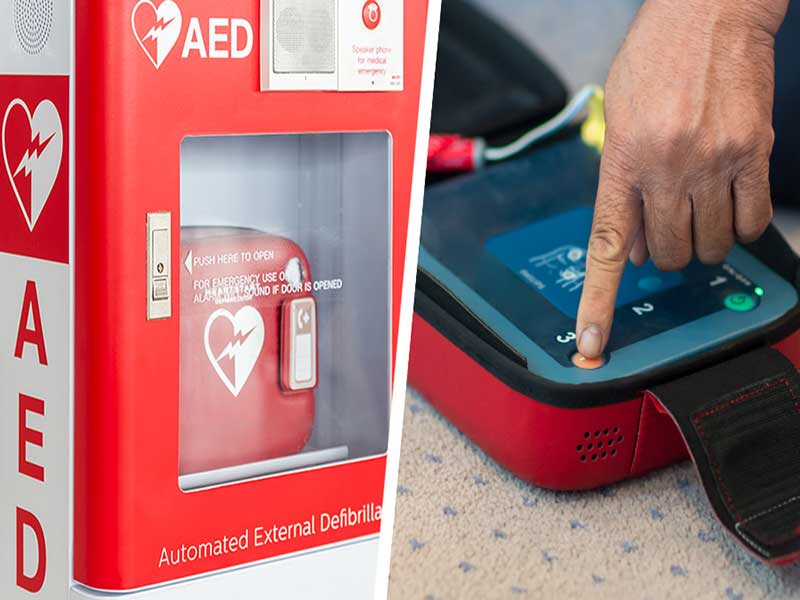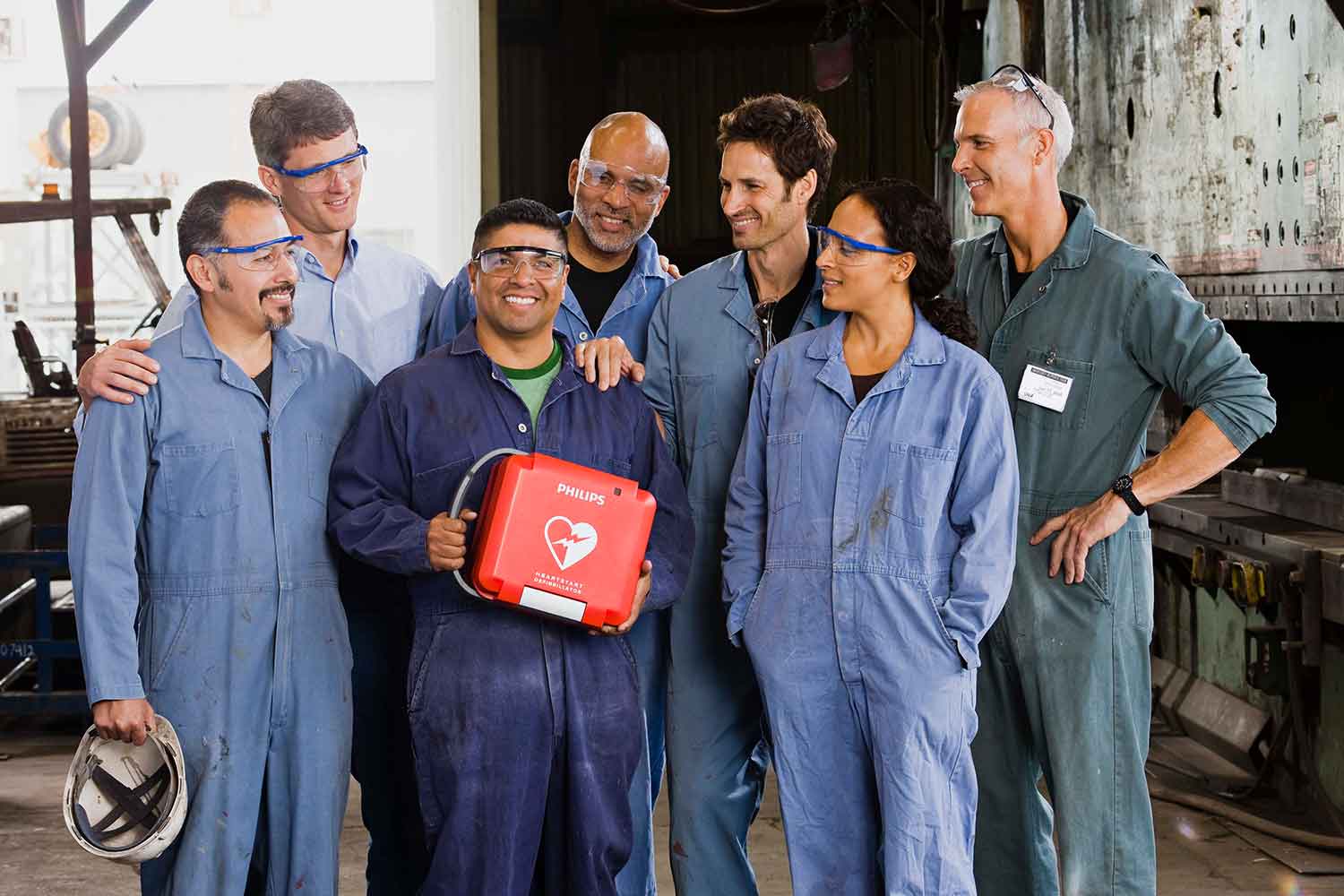You’ve made the decision to implement an AED program, you understand the legal responsibilities, and hopefully, you have found a reputable distributor to work with.
You are aware that AEDs on the market for public use are easy to use and require minimal training — all offering the same basic functions. Even the most basic models of AEDs include instructions for applying pads to a sudden cardiac arrest (SCA) victim, an analyze button to press so the unit can analyze the victim’s heart rhythm, and a stand clear warning for when a shock is given. They also advise when to press the shock button, or if it is a fully automatic system, it indicates that a shock is about to be given.
Beyond just basic CPR guidance, some AEDs offer advanced features that provide feedback and evaluation of CPR as it is given. As you are looking over the different models with all the various features, you wonder…do we really need all the bells and whistles? Do we really need that fancy CPR Feedback device?
Obviously, your budget, work environment, and the comfort level of responders will offer guidance in this decision. Advanced features using CPR feedback technology may result in a better outcome for a victim of SCA. To follow are additional factors to take into consideration and help answer this question.
Critical Role of CPR during SCA
Sudden Cardiac Arrest (SCA) is the leading cause of death in the United States. More than 420,000 out-of-hospital cardiac arrests occur every year in the United States — about 10,000 of those occur while at work. Unfortunately, more than 95 percent of the victims die before they reach the hospital. A big problem with a poor outcome.
The key to survival from an out of hospital sudden cardiac arrest (SCA) is timely initiation of the American Heart Association (AHA) Chain of Survival, which consists of:
- Recognition and activation of the emergency response system – calling 911
- Early CPR – providing chest compressions and rescue breathing
- Early defibrillation – using an AED
- Basic and advanced emergency medical services – transfer of care to EMS
- Advanced life support and post-cardiac arrest care – hospital
A strong Chain of Survival improves chances of survival and recovery for victims of cardiac arrest. Cardiopulmonary resuscitation (CPR) is a critical step in this process. CPR performed within the first few minutes of a cardiac arrest can double or triple the victim’s chance of survival.
CPR is a lifesaving technique used on someone who has stopped breathing or whose heart has stopped. CPR can keep oxygenated blood flowing to the brain and other vital organs until a normal heart rhythm can be restored.
While CPR is critical for keeping blood and oxygen flow, it cannot correct the heart rhythm. The use of an AED increases overall survival rates by 60 percent.
Initiating CPR and defibrillation within 3-5 minutes of collapse, before EMS arrives, dramatically improves chances of survival.
It is key to remember that not every cardiac arrest victim needs a defibrillation shock (AED), but every victim needs CPR to have chance of survival.
High-Quality CPR
While CPR training is an essential part of an AED program, it does not guarantee high-quality CPR will be given at the time of need.
High-quality CPR is a critical factor in improving cardiac arrest survival rates. In 2008, The AHA released a statement instructing bystanders who witness the sudden collapse of an adult to call 911 and provide high-quality chest compressions by “pushing hard and fast in the middle of the victim’s chest.”
The 2010 AHA Guidelines for CPR and ECC (Emergency Cardiovascular Care) outlines the standards for high-quality CPR, defining the five critical components of high-quality CPR.
- Minimize interruptions in chest compressions
- Provide compressions of adequate rate and depth,
- Avoid leaning between compressions, and
- Avoid excessive ventilation
The guidelines specify that in order for chest compressions to adequately generate critical blood flow and oxygen to the heart and brain, they should be provided at a rate of at least 100 per minute and a depth of at least 2 inches.
In 2013, the AHA Consensus Statement, published in the journal Circulation, emphasized “to maximize survival from cardiac arrest, the time has come to focus efforts on optimizing the quality of CPR…CPR is a lifesaving intervention and the cornerstone of resuscitation from cardiac arrest.”
The AHA statement further concluded “survival from cardiac arrest depends on early recognition of the event and immediate activation of the emergency response system, but equally critical is the quality of CPR delivered.”
SCA victim survival is directly linked to the quality of CPR. Studies have found when the compression rate falls below 100 per minute, the survival rate after an out-of-hospital cardiac arrest falls by 30%. Similarly, data indicates an increased survival rate of out-of-hospital SCA in victims where the chest compression rate was adequate.
Obstacles to Providing High-Quality CPR
Lay responders, even when CPR-trained, my not perform high quality CPR. Even for seasoned health care professionals, they have difficulty knowing if they are providing high-quality CPR according to current AHA recommendations.
Several common factors compromise CPR quality given by non-professional rescuers, even those trained in CPR.
- Compression depth – force is not hard enough to achieve 2 inches of depth
- Compression rate – rhythm is less than 100 per minute
- Size of victim – It is difficult for a non-professional to determine how hard compressions should be, particularly with a larger victim
- Fatigue – performing CPR is tiring (just ask a rescue professional!), and without backup or feedback, compression depth and timing are likely lessened as fatigue sets in
- Stress – SCA is a highly stressful life or death situation, which can adversely affect a person’s ability to perform high quality CPR – feedback offers calming guidance/reminders
- Confidence – the lay person has never performed in a rescue situation and may lack confidence in ability to perform CPR, which can affect quality
CPR Feedback technology, by offering calming guidance and encouragement in a real-time situation, is an excellent solution to overcoming these obstacles and optimizing the outcome of a cardiac arrest.
What is CPR Feedback?
Accessibility and use of an AED greatly increases a cardiac arrest victim’s chance for survival over just CPR alone.
Since many lay rescuers may not perform the quality of CPR necessary, AEDs that include CPR feedback offer a tremendous opportunity to increase the chances of survival for the SCA victim.
CPR feedback is not the same as CPR instruction or guidance. Many AED models offer CPR instruction via step-by-step videos, audio or visual aids.
CPR feedback offers real-time, constant analysis of the quality of CPR during a life-saving cardiac arrest. It guides the rescuer through the critical chain of survival during SCA.
On currently available AED models, CPR feedback technology includes one or more of the following forms:
- Integrated adaptive metronome for real-time tracking of compression rate
- Visual prompts on rate of compressions
- Visual prompts on depth of compressions
- Voice prompts to increase rate or continue rate, such as “push faster”, “push slower”, and “good speed”
- Voice prompts to increase depth or continue depth of compression, such as “push harder”, and “good compression”
- Visual feedback that indicates the rescuer is coming off the chest of victim to allow for full recoil
- Numeric display of rate and depth of compressions.
- Event Analysis that can be used to evaluate effectiveness of CPR provided
- Voice prompt when to begin CPR to minimize interruption, such as “begin CPR”
CPR feedback advises and encourages a rescuer to achieve optimum high-quality CPR as defined by AHA. It also increases confidence and offers reassurance to a lay rescuer.
Does CPR Feedback Technology Really Make a Difference?
The goal of CPR feedback is to prompt, guide, and provide confidence to a rescuer in a highly stressful situation. Responding confidently and appropriately is crucial during SCA. Just the audiovisual prompts alone can settle the rescuer’s nerves enough to provide high quality CPR. Devices with CPR feedback can improve CPR in real time.
Unfortunately, knowing when and how to perform high quality CPR actually doing it are two different things. A JAMA (Journal of the American Medical Association) study showed that even when the average compression rate is great, with no feedback, the average patient ends up receiving just 18 effective compressions per minute. This is due to some compressions not being deep enough and to pauses that occur during CPR.
An Annals of Emergency Medicine study concluded that implementing real-time audiovisual CPR in addition to CPR training significantly improved CPR quality, increased survival rate, and resulted in favorable functional outcomes after an out-of-hospital cardiac arrest.
The AHA Consensus Statement points out that with “newer technology capable of monitoring CPR parameters during resuscitation and the ability to monitor the quality of CPR in real time, given the insights into clinical performance and discoveries in optimal practice, monitoring of CPR quality is arguably one of the most significant advances in resuscitation practice in the past 20 years and one that should be incorporated into every resuscitation and every professional rescuer program.”
The AHA statement also encourages the use of real-time CPR feedback to optimize outcomes.
Resources
http://cpr.heart.org/AHAECC/CPRAndECC/UCM_473161_CPR-and-ECC.jsp
http://circ.ahajournals.org/content/early/2013/06/25/CIR.0b013e31829d8654.full.pdf
http://www.annemergmed.com/article/S0196-0644%2812%2901853-7/fulltext
http://www.jemsdigital.com/jems/201401?pg=41#pg41
http://www.jems.com/articles/print/volume-38/issue-11/patient-care/case-cpr-feedback-devices.html


